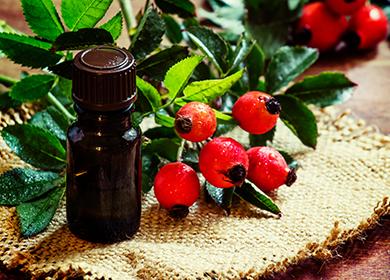The content of the article
Rosehip is an integral part of the “grandmother’s first-aid kit”. This is a unique plant with medicinal fruits and beautiful flowers.
There is a legend according to which the Greek goddess of love Aphrodite, learning about the death of her chosen one, ran through the thickets in emotions. Branches scratched the goddess. The drops of her blood remaining on the bushes turned into luxurious buds of wild rose - wild rose.
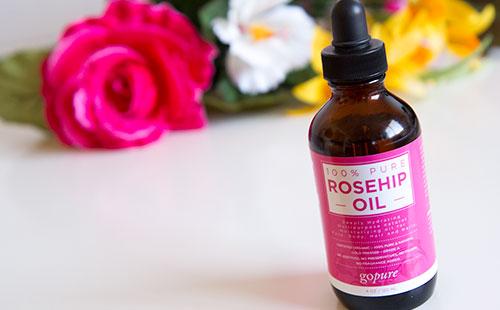
The plant has versatile healing properties. It is able to heal wounds and cracks, relieves inflammation, improves the functioning of the digestive system and the cardiovascular system, soothes and relieves stress, is a diuretic and removes bile from the body.
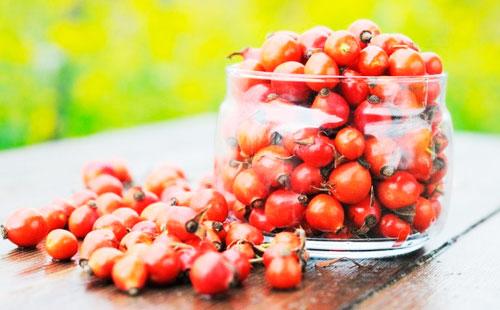
Vitamin C - the anti-aging factor of cosmetologists
The beneficial properties of rosehip vegetable oil and its unique composition have made the product especially popular in home cosmetology. What is so important about this substance?
A feature is the high content of ascorbic acid in the chemical composition of wild rose. This plant has ten times more vitamin C than currants. And 50 times more than in lemon!
For our body, this is immunity, and for the skin - youth. Indeed, ascorbic acid is a powerful antioxidant that blocks the negative effects of harmful substances and factors, slowing down the aging process and protecting the epidermis from diseases. It is interesting that it is rosehip that is used in the production of a number of ascorbine-containing medications.

How it improves the skin and in what cases it can harm
But the product is not rich in ascorbic acid. The beneficial properties of rosehip oil for the face are also determined by unsaturated fatty acids, macro- and microelements. The following are the main components of rosehip oil, which affect the condition of the skin of a person.
- Unsaturated fatty acids. And in the rosehip oil their whole "portfolio". These are useful substances, the lack of which immediately affects the condition of the skin. For example, a deficiency of linolenic and linoleic acids causes acne. In addition, linoleic acid evens out the water balance and retains moisture in the layers of the epidermis. This solves the problem of intensive skin hydration.Also, the substance "reflects" ultraviolet radiation. Oleic acid, which is also part of wild rose oil, stimulates the production of collagen and causes a lifting effect. And myristic acid helps to penetrate the cells and gain a foothold in other important components.
- "Vitamins of beauty." Here are B vitamins, which tighten and moisturize the skin, make it silky, and prevent the appearance of acne. Rosehip oil also contains vitamin E, which enriches the skin with oxygen and smooths the grooves even around the eyes. Vitamin K, which is used to heal plastic postoperative sutures, is also found in the wild rose product. This component, among other things, has a whitening effect and removes pigmentation. Vitamin A prevents aging. A nicotinic acid improves skin “respiration”, retains moisture, relieves inflammation and prevents the appearance of scales.
- Macro and microelements. Wild rose oil contains potassium, which regulates the water balance of the epidermis. Ferum improves blood circulation, tones. Calcium normalizes the production of sebum, increases the elasticity of the skin. Magnesium relieves puffiness, improves texture. Phosphorus gives a healthy color and tightens. Zinc prevents acne.
The main tasks that rosehip oil solves when it comes into contact with our skin are hydration and rejuvenation. Also indicated for use are swelling, circles under the eyes, dark spots, scars and irritations.
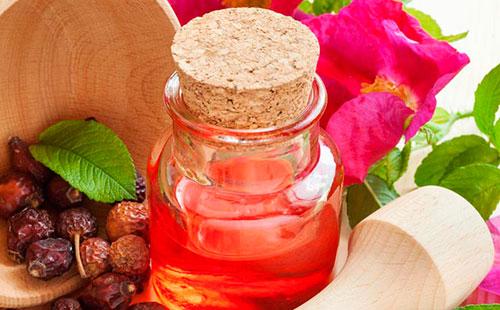
Simple ways to use
According to reviews, rosehip oil is well suited for the face from wrinkles that have already appeared, reducing their depth, and slows down the process of new grooves. Moreover, the results are visible after several weeks of regular procedures. And you can use a wild rose constantly, taking traditional preventive breaks.
Girls who struggle with the problem of dryness of the epidermis can even apply rosehip oil to their face instead of cream or moisturize their lips. To do this, you need a cotton pad and directly a cosmetic product. Also, a wild rose is not forbidden to be added to store tubes. The acceptable ratio is about four drops per teaspoon of finished cosmetics.
This tool is also suitable for massage of the face and body. In its pure form, rosehip oil is also used in the treatment of skin diseases and to get rid of pigmentation, scars after acne. In this case, compresses are made. For this, a gauze cut with slits for the eyes is impregnated with a substance and applied to the face for half an hour. The procedure for obtaining an operational result is preferably repeated several times a day.
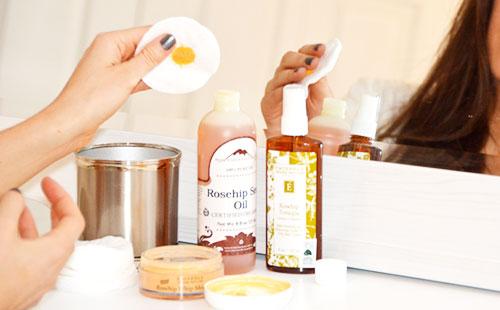
Seven popular recipes
Face masks from rosehip oil at home are also popular. The following are the simplest and most common recipes.
Super humidification with yolks
- In a bowl with a fork or blender, beat two yolks of chicken eggs.
- Combine with a teaspoon of wild rose oil.
- Stand for 20 minutes.
- Remove with warm boiled water, milk or herbal decoction.
- Apply your daily cream.
Anti-aging “cocktail” with oatmeal and milk
- Bring the milk to a boil. Quantity - half a glass.
- Grind oatmeal with a coffee grinder. The required amount of flour is two tablespoons.
- Pour oatmeal with hot milk.
- Cool the resulting mixture and combine with a teaspoon of wild rose juice.
- Stand for 20 minutes.
- Remove with warm boiled water, milk or herbal decoction.
- Apply your daily cream.
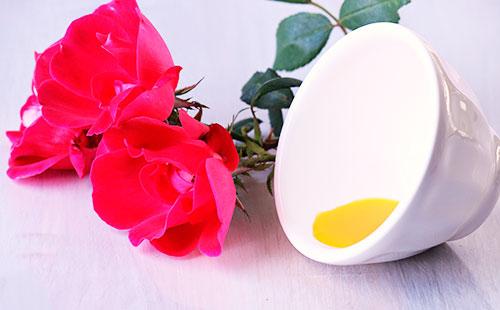
Anti-aging option with oils and riboflavin
- Combine two tablespoons of regular baby cream and a teaspoon of aloe juice.
- Add vitamin B2 purchased at the pharmacy. The amount of liquid riboflavin is 10 drops.
- Combine with olive oil. Quantity - 20 drops.
- Combine with rosehip oil. Quantity - 10 drops.
- To sustain 20-30 minutes.
- Remove with warm boiled water, milk or herbal decoction.
- Apply your daily cream.

Vitamin nutrition against "crow's feet"
- Combine a tablespoon of rosehip oil and liquid pharmacy vitamins A and E. The amount of vitamins - three drops each.
- Use your fingertips to drive the resulting mixture under the eyes.
- Do not rinse, you can get wet with a napkin.
- Apply at night and after waking up.
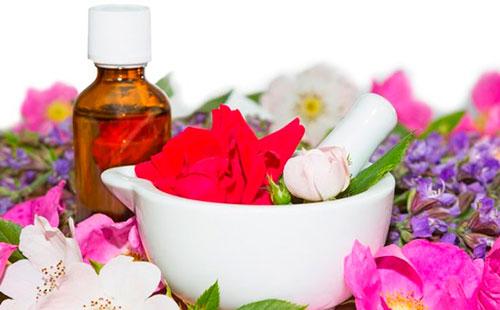
Anti-wrinkle with ethers
- Combine a tablespoon of rosehip oil with a tablespoon of wheat germ oil.
- Enrich with essential oils geraniums and patchouli. Quantity - two drops.
- It is recommended to use at night without rinsing.
With bran and nettle to relieve puffiness
- Prepare nettle infusion by pouring a tablespoon of the leaves of the plant with a glass of boiling water. Insist for half an hour, then strain with a gauze cut.
- Combine the infusion with a tablespoon of wheat bran.
- Add wild rose oil. Quantity - a teaspoon.
- To sustain 20-30 minutes.
- Remove with warm boiled water, milk or herbal decoction.
- Apply your daily cream.
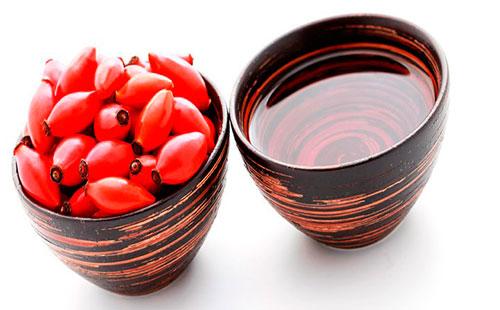
With honey for elasticity and silk
- In a bowl with a fork or blender, beat a teaspoon of liquid honey and one yolk of a chicken egg.
- Enrich with a teaspoon of rosehip oil.
- Soak for 15-20 minutes.
- Remove with warm boiled water, milk or herbal decoction.
- Apply your daily cream.
In the ripening season of wild rose, at the end of summer, you can additionally wash yourself with a decoction of the fruits and leaves of this plant. Also, lovers of natural care products are advised to make ice cubes from the infusion of wild roses.
If the product is suitable for your skin type, then the use of rosehip oil for the face is limited only by your desire. But if you want to further strengthen the body from the inside, then you need to know that the substance can cause harm. You can not drink wild rose oil with pancreatitis, gallstone disease, ulcers and with any problems with blood coagulation.
